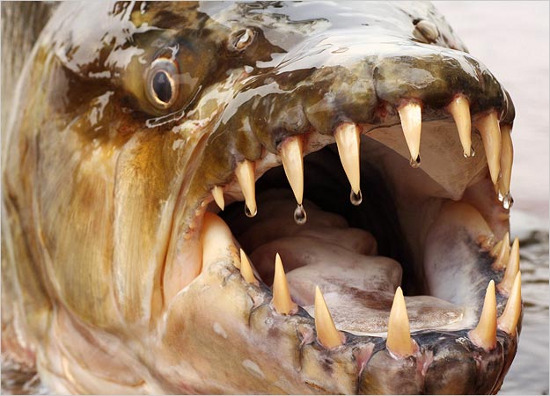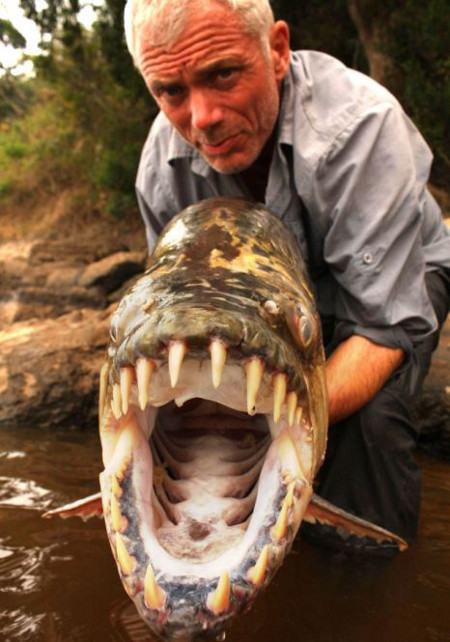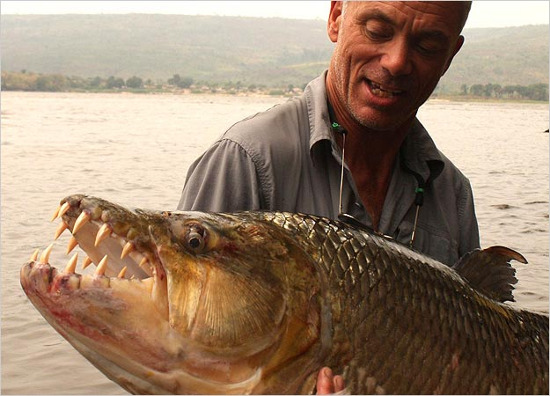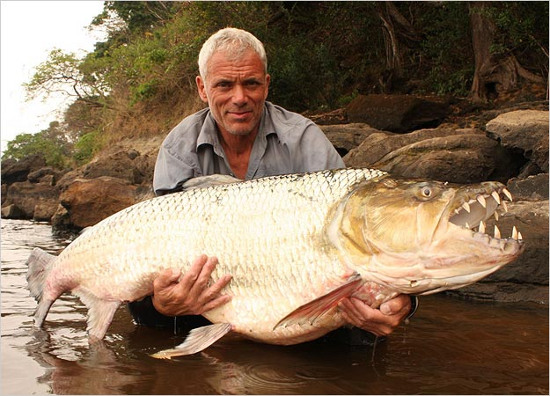The Goliath Tigerfish is one of the most aggressive freshwater fish species on the planet. It is considered a freshwater monster in the Congo River basin.
The Goliath Tigerfish is a giant relative of the infamous carnivorous Piranha.
They inhabit some of the most remote rivers in the world, being abundant in the Congo River basin, the Lualaba River, Lake Upemba, and Lake Tanganyika in Africa.
It is one of the most aggressive and hardest-to-catch freshwater fish species in the world. They are incredibly cunning. The most effective way to catch them is by fishing, but doing so is extremely challenging.
What stands out about the Goliath Tigerfish is its incredible size and weight; they use their razor-like teeth to tear apart their prey. The lifespan of this species in the wild is still undetermined, but in captivity, it can live up to 10 to 15 years.

With sharp teeth, they can tear off large chunks of flesh.
Anglers are very passionate about catching this giant fish, traveling from Europe to Africa to seek out rivers that are home to the Goliath Tigerfish. An angler who catches a giant Goliath Tigerfish quickly gains fame and is celebrated on fishing forums.
With their sharp teeth, they can bite deeply and tear off large chunks of flesh. Therefore, anglers often do not grab the tigerfish with their hands immediately; they must use a hook to latch onto its jaw before daring to pull it ashore.
Some anglers have been reckless, reaching down to grab a tigerfish, only to have it unexpectedly lunge and bite off part of their hand or even a finger.

The Goliath Tigerfish has a set of very sharp triangular teeth.
Although catching a tigerfish is very difficult, when anglers do succeed, they usually take a photo for memory and then release them back into the river. They are a very rare species, so releasing them allows other anglers the chance to achieve recognition.
Crocodiles are considered the most ferocious creatures in the water, with their large bodies, yet they often fall prey to these giant tigerfish. There have been instances where a crocodile weighing 200 kilograms was devoured by a 50-kilogram tigerfish.
Although crocodiles are strong, their large bodies make them less agile than tigerfish. The tigerfish attacks from behind, using its strong jaws to bite and tear through the tough skin of the crocodile. The crocodile will die in agony.


They are a very cunning species. The most effective way to catch them is by fishing, but doing so is extremely challenging.
The Goliath Tigerfish is an excellent swimmer and sometimes hunts in packs. When other fish accidentally swim into their waters, they will be attacked in the most aggressive manner possible. The attack usually begins with the tigerfish circling its prey before striking. With their sharp teeth, they can bite deeply and tear off large chunks of flesh.
They can even tear a catfish weighing nearly 30 kilograms in half with a single bite. The sensory organs of this species have also developed significantly to aid in hunting activities. The Goliath Tigerfish has an internal swim bladder that functions similarly to how our eardrums detect changes in air pressure as sound; this swim bladder acts as a vibration sensor when a fish moves nearby.
Despite being an aggressive fish, they rarely attack humans. However, human remains are often not intact if they float in rivers inhabited by Goliath Tigerfish.
The Goliath Tigerfish has excellent eyesight, allowing it to hunt effectively in dark waters and fast-flowing currents. They often lie in wait in dark waters, attacking their prey suddenly.
In fast-flowing waters, while prey struggles against the current, the giant tigerfish calmly swims around, choosing the right position before launching a swift attack. Its bite can sever the prey in half in an instant.
On the rivers of Africa, especially in the Congo, if there is half a fish carcass floating in the water with jagged bite marks, it is undoubtedly the result of an attack by a Goliath Tigerfish. It bites its prey in half and leaves one half for another predator to enjoy.
This species can reach a maximum size of up to 2 meters and weigh nearly 100 kilograms. Its lifespan can extend to 15 years in favorable natural environments.
















































